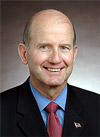|
Campus News
Ryan Address
Highlights Quality of Incoming Freshman Class,
Innovation in Education, Increased Research Funding
by Greta Petry
 |
Interim President
John R. Ryan |
Noting the importance of maintaining �our momentum
into the future,� Interim President John R. Ryan
focused his April 28 report to the faculty on
the steps UAlbany is taking to recruit and retain
high-quality faculty and students, and enhance
academic and research programs.
Ryan highlighted University progress in attracting
a talented freshman class, faculty success in
garnering research funding and awards, and significant
investments in both new and renovated facilities.
He also outlined challenges facing the University.
�This year we expect that 38 percent of Albany�s
traditionally admitted freshman class will meet
the SUNY Group 1 criteria, up from last year�s
36.1 percent,� said Ryan. With about 17,000 applications
in, average SATs at 1191 and average GPAs at 91.2,
the academic profile of the incoming class is
similar to last year�s.
Ryan, who was tapped to lead the University at
Albany on an interim basis on February 24, noted
that while the New York State Legislature has
not yet adopted a budget, the Executive Budget
increases SUNY System�s core instructional budget
by $26 million, or 1.4 percent over 2003-2004.
The president said that along with Chancellor
King, he is �strongly� advocating against restructuring
the Tuition Assistance Program and for restoration
of the proposed $820,000 reduction to the statewide
Educational Opportunity Program.
While the Executive Budget included $79 million
for UAlbany�s capital budget, it did not include
funding to equip the Life Sciences building and
several critical maintenance projects, Ryan said,
adding that he is �working diligently with the
Legislature to increase capital funding to the
campus.�
Overall, Ryan said the fiscal picture has �improved
slightly� for UAlbany, although it is still �an
attention grabber.� The projected shortfall for
2004-2005 is slightly more than $7 million. The
strategy is to continue �investment in faculty
recruitment, library acquisitions, technology,
and other infrastructure improvements� especially
in a challenging fiscal environment, if we are
to continue to be successful in recruiting and
retaining high-quality faculty and students and
enhancing the University�s academic and research
programs,� he said.
�As we move forward, it will be important for
all of us to keep our focus, be open to change,
and to be proactive in identifying and developing
more efficient and productive ways to do our work,�
Ryan said, adding that the institution will continue
its strategic focus on faculty recruitment, academic
programs, health and safety issues, and increasing
and diversifying revenue streams.
Many improvements to academic buildings will
go forward this summer, including the renovation
of eight classrooms in the Humanities Building
basement, leveraging a matching gift to create
a �premier� classroom in the Business building,
and renovating two more lecture centers. On the
downtown campus, the second phase of a three-year
renovation project of Milne Hall will take place.
The Life Sciences building is completed, and Husted
Hall downtown will be emptied out in preparation
for renovations.
For students, Oneida Hall on Indian Quad is currently
undergoing renovations, which are about 75 to
80 percent complete. Roofing work will be conducted
after students leave for the semester, and construction
is expected to be finished by mid-July. Melville
Hall is slated to be taken off line for renovation
next fall.
During his speech, the president noted the creation
of the College for Nanoscale Sciences and Engineering,
�which promises to be a most significant and important
development for the future of the University at
Albany. In establishing this pioneering new academic
unit at Albany, the Chancellor and the Trustees
are reaffirming their confidence in the traditions
and quality of this institution to support and
nurture innovation in graduate education and the
pursuit of new knowledge.�
Ryan thanked Provost and Vice President for Academic
Affairs Carlos Santiago for his leadership at
UAlbany over the past 16 years. He wished Santiago
and Professor Azara Santiago-Rivera well. Santiago
has accepted the position of Chancellor of the
University of Wisconsin-Milwaukee. Ryan also thanked
Vice President for Outreach David Gilbert for
his work in securing funding for the School of
Public Health and a research agenda for the Gen*NY*sis
Center for Cancer Genomics, among others. Gilbert
has also accepted a position at the University
of Wisconsin-Milwaukee.
In his speech, the interim president announced
the May 7 farewell event for President Karen R.
Hitchcock, president of UAlbany since 1995, and
said as a result of her leadership, �Albany has
developed a national reputation as a vibrant place,
a center of excellence in research and education.
This reputation is increasingly reflected in the
quality of the faculty and students who are attracted
to this institution.�
In addition to introducing the previously announced
winners of this year�s Excellence Awards, Ryan
announced that Professor James Acker of the School
of Criminal Justice has been named a Distinguished
Teaching Professor, the highest rank in the State
University of New York system.
He also announced this year�s Collins Fellow
Award winners, Distinguished Teaching Professor
of Public Affairs and Policy David P. McCaffrey
and Distinguished Service Professor of Sociology
Glenna D. Spitze. The Collins Fellow Award, named
for the late Evan Revere Collins, is presented
to senior members of the teaching faculty to recognize
�extraordinary devotion to the University and
the people in it over a sustained period of time.�
In the area of research funding, Ryan noted that
the value of new research awards increased by
63 percent, to $193 million in fiscal year 2002.
�The growth in the value of new research awards
is a leading indicator of the research and development
expenditures to follow in fiscal year 2003 and
thereafter,� he said.
While discussing the achievements of athletics
this past year, Ryan said he was impressed to
see the entire UAlbany football team helping out
at Campus Cleanup Day on April 27. �That�s leadership,�
he said.
For the complete text of
Ryan's speech, got to: www.albany.edu/news/campus_news/2004/apr2004/ryan_spring_faculty.htm.
|
